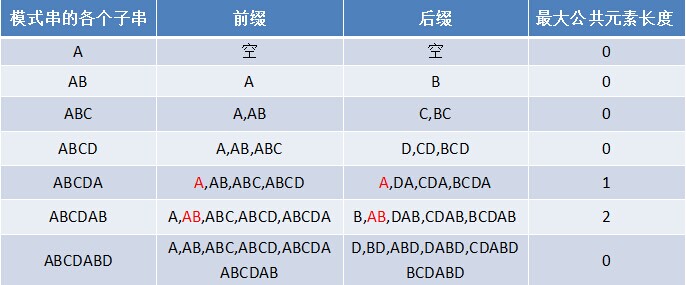第3章:LeetCode--算法:strStr KMP算法
https://leetcode.com/problems/implement-strstr/ 28. Implement strStr()
暴力算法:
int ViolentMatch(char* s, char* p) { int sLen = strlen(s); int pLen = strlen(p); int i = 0; int j = 0; while (i < sLen && j < pLen) { if (s[i] == p[j]) { //①如果当前字符匹配成功(即S[i] == P[j]),则i++,j++ i++; j++; } else { //②如果失配(即S[i]! = P[j]),令i = i - (j - 1),j = 0 i = i - j + 1; j = 0; } } //匹配成功,返回模式串p在文本串s中的位置,否则返回-1 if (j == pLen) return i - j; else return -1; }
KMP(Knuth-Morris-Pratt)算法:
当T[i] != P[j]时
有T[i-j ~ i-1] == P[0 ~ j-1]
由P[0 ~ k-1] == P[j-k ~ j-1]
必然:T[i-k ~ i-1] == P[0 ~ k-1] -->because k<j
如果给定的模式串是:“ABCDABD”,从左至右遍历整个模式串,其各个子串的前缀后缀分别如下表格所示:

也就是说,原模式串子串对应的各个前缀后缀的公共元素的最大长度表为(下简称《最大长度表》):
KMP 算法:=NEXT数组下标从0开始更容易理解=
class Solution {
public:
void GenNext(string p, int next[]){
int plen = p.size();
next[0] = 0;
int j = 0;
for(int i=1; i<plen; ){
if(p[j] == p[i]){
next[i] = j+1;
j++;
i++;
}
else{
if(j!=0)
j = next[j-1];
else{
next[i] = 0;
i++;
}
}
}
}
int strStr(string haystack, string needle) {
int slen = haystack.size();
int plen = needle.size();
if(slen < plen) return -1;
if(needle == "" ||haystack == "") return 0;
int i=0, j=0;
int next[plen];
GenNext(needle, next);
while(i<slen && j<plen){
if(haystack[i]==needle[j]){
i++;
j++;
}else{
if(j!=0)
j = next[j-1];
else
i++;
}
}
if(j==plen) return i-j;
return -1;
}
};
KMP算法参考:https://www.cnblogs.com/ZuoAndFutureGirl/p/9028287.html
更高级搜索算法:
BM算法 Sunday算法https://www.cnblogs.com/ZuoAndFutureGirl/p/9028287.html




